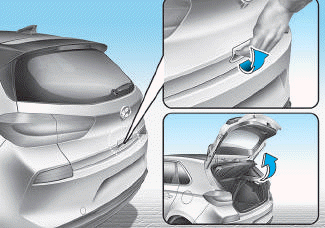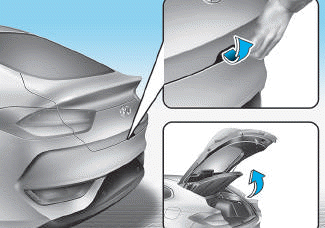Hyundai i-30: What to do in an emergency / Jump starting
Jump starting can be dangerous if done incorrectly. Follow the jump starting procedure in this section to avoid serious injury or damage to your vehicle. If in doubt about how to properly jump start your vehicle, we strongly recommend that you have a service technician or towing service do it for you.
WARNING
To prevent SERIOUS INJURY or DEATH to you or bystanders, always follow these precautions when working near or handling the battery:
 Always read and follow
instructions carefully
when handling a battery.
Always read and follow
instructions carefully
when handling a battery.
 Wear eye protection
designed to protect the
eyes from acid splashes.
Wear eye protection
designed to protect the
eyes from acid splashes.
 Keep all flames, sparks,
or smoking materials
away from the battery.
Keep all flames, sparks,
or smoking materials
away from the battery.
 Hydrogen is always
present in battery cells,
is highly combustible,
and may explode if ignited.
Hydrogen is always
present in battery cells,
is highly combustible,
and may explode if ignited.
 Keep batteries out of
reach of children.
Keep batteries out of
reach of children.
 Batteries contain sulfuric
acid which is highly
corrosive. Do not allow
acid to contact your
eyes, skin or clothing.
Batteries contain sulfuric
acid which is highly
corrosive. Do not allow
acid to contact your
eyes, skin or clothing.
If acid gets into your eyes, flush your eyes with clean water for at least 15 minutes and get immediate medical attention. If acid gets on your skin, thoroughly wash the area. If you feel pain or a burning sensation, get medical attention immediately.
- When lifting a plastic-cased battery, excessive pressure on the case may cause battery acid to leak. Lift with a battery carrier or with your hands on opposite corners.
- Do not attempt to jump start your vehicle if your battery is frozen.
- NEVER attempt to recharge the battery when the vehicle’s battery cables are connected to the battery.
- The electrical ignition system works with high voltage. NEVER touch these components with the engine running or when the ignition switch is in the ON position.
- Do not allow the (+) and (-) jumper cables to touch. It may cause sparks.
- The battery may rupture or explode when you jump start with a low or frozen battery.
NOTICE
To prevent damage to your vehicle:
- Only use a 12-volt power supply (battery or jumper system) to jump start your vehicle.
- Do not attempt to jump start your vehicle by push-starting.
Information
An inappropriately disposed battery can be harmful to the environment and human health. Dispose the battery according to your local law(s) or regulations.
 If the engine will not start
If the engine will not start
If the engine doesn't turn over
or turns over slowly
Be sure the shift lever is in N
(Neutral) or P (Park) if it is an automatic
transmission/dual clutch
transmission vehicle...
 Jump starting procedure
Jump starting procedure
1. Position the vehicles close enough
that the jumper cables will reach,
but do not allow the vehicles to
touch.
2. Avoid fans or any moving parts in
the engine compartment at all
times, even when the vehicles are
turned off...
Other information:
Hyundai i30 (PD) 2018-2025 Owner's Manual: Fan speed control
Turn the knob to the right to increase the fan speed and airflow. Turn the knob to the left to decrease fan speed and airflow. Setting the fan speed control knob to the “0” position turns off the fan. NOTICE Operating the fan speed when the ignition switch is in the ON position could cause the battery to discharge...
Hyundai i30 (PD) 2018-2025 Service Manual: Sub Frame
Repair procedures Removal 1. Loosen the wheel nuts slightly. Raise the vehicle, and make sure it is securelysupported. 2. Remove the front wheel and tire (A) from the fronthub...
Categories
- Manuals Home
- 3rd Generation i30 Owners Manual
- 3rd Generation i30 Service Manual
- Brake/clutch fluid
- FCA sensor
- Battery replacement
- New on site
- Most important about car
Tailgate
Opening the tailgate

■ 5 Door, Wagon

■ Fastback
